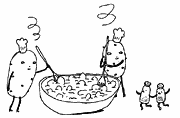FORGET ABOUT the World Series, fireworks on the Fourth of July, or the thrill of shaking sand out of your bathing trunks after that first visit to the beach. For my money, the best part of summer is the food. The long, hot months between the Memorial and Labor holidays blur into an endless series of picnics and barbecues, full of Igloo coolers packed with ice-cold beers, burgers sizzling on the grill, and—best of all—mounds of creamy potato salad.
I am not alone in my passion for this all-American favorite. According to a 1998 study, the average US citizen consumes over 140 pounds of potatoes every year. The potato is the world’s leading vegetable crop.
But the lowly spud was not always regarded with esteem. For centuries, Europeans feared this tuber, imported from the New World, as poisonous or dismissed it as fodder for farm animals, hardly fit for consumption by decent people. According to legend, Scottish Protestants refused to plant this crop because they could find no mention of it in the Bible. (Irish Catholics overcame this obstacle by sprinkling seed potatoes with holy water and planting them on Good Friday.) Prussian ruler Frederick the Great resorted to threats of violence in order to convince his subjects to cultivate and consume potatoes as a hedge against famine.
Nowadays, hardly a month goes by that spuds aren’t celebrated in glossy cooking magazines. In New York City, you can’t walk a few blocks without finding a frites vendor peddling Belgian-style cones of deep-fried potatoes slathered in mayonnaise and other flavorful dressings. And we’ve probably all read, at some point, about the birth of potato chips, invented by a hotel chef in Saratoga Springs, NY, in the early 1850s. But did you ever give a thought to who invented potato salad? Don’t feel bad. Apparently no one else has, either. The sum total of literature on the history of this deli classic could be printed on the single side of a paper napkin.
Queen Anne resident Larry Zuckerman, author of The Potato: How the Humble Spud Rescued the Western World (North Point Press, 1998), isn’t at all surprised that trying to pinpoint the invention of potato salad raises more questions than it answers. “That would be like asking ‘Who invented salad?'” he notes, though he feels confident that some variation of the dish probably popped up on the dining tables of 18th-century France (even though mayonnaise wouldn’t be invented until the 19th century); King Louis XVI, who ruled the country from 1754 to 1792, planted potato plantations to encourage their popularity.
IF WE ACCEPT the dictionary definition of a “salad” as a “combination of ingredients”— meat, eggs, vegetables, etc.—”usually served cold with a dressing,” then potato salad per se probably dates back to before the 1500s. The Quechuas (Incas) of Peru sometimes grew as many as 200 different kinds of potatoes in the same field. To preserve the harvest, they developed primitive methods of freeze-drying. One technique was to boil the tubers, then leave them out to dry in the cold mountain air overnight. These dehydrated papa seca could then be reconstituted and prepared in a variety of ways.
In Germany, where potatoes were introduced circa 1620, Kartoffelsalat—spuds and crumbled bacon tossed with a sweet-sour, vinegar dressing—has long been a popular side dish. Although some food snobs may scoff at classifying a hot dish as a salad, bear in mind that there are plenty of Americans who wouldn’t think twice about lumping Jell-O (a dessert if ever there was one) into the fruits-and-vegetables category.
Although historical data on potato salad remains in scant supply, an astonishing number of recipe variations for this simple fare exist. I prefer to flesh out my own version with traditional ingredients: chopped onion, celery, hard-boiled eggs, and salt and pepper. If I’m feeling extra fancy, maybe I’ll fold in some chopped dill or parsley for color. Other folks insist on adding olives or pickles. Soul diva Patti LaBelle calls for diced bell peppers in her recipe. At a certain point, though, things get ridiculous; capers or anchovies don’t make a potato salad any classier than dolling up a mule with an Easter bonnet does (plus it’s not nearly as amusing). Mayonnaise is the most popular dressing, but sour cream also has loyal followers, and mustard, vinaigrette, and even ketchup (for “pink” potato salad) can be used, too.
With over 5,000 types of potato, it comes as no surprise that opinions differ on the best type for salads. Mealy varieties, such as russet and Idaho potatoes, yield a creamier consistency. But if you’re a fussbudget about presentation, a variety with a more waxy flesh is encouraged, as they hold their shape better when chopped. Personally, I swear by red-skinned new potatoes. But I’ll stay out of your kitchen if you stay out of mine.
Regardless of the variety you choose, always boil the potatoes whole, in their jackets, to preserve their flavor. Cut them when they are just cool enough to handle, and toss them with the dressing while still slightly warm—the better to absorb the wet stuff. And, God forbid, if you come down with food poisoning from potato salad, don’t blame the mayonnaise. These days, the culprit is usually the cooked potatoes; their low acidity makes them a haven for bacteria if improperly stored. Hmmm. Maybe those early Europeans weren’t so crazy after all.






